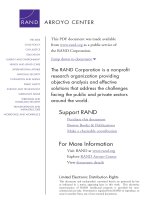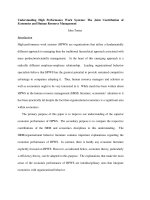HUman resource managemenr 2e s keiman chapter13
Bạn đang xem bản rút gọn của tài liệu. Xem và tải ngay bản đầy đủ của tài liệu tại đây (164.13 KB, 33 trang )
Chapter 13
Meeting Employee Safety
and Health Needs
© 2010 Cengage Learning. Atomic Dog is a trademark used herein under license. All rights reserved.
Chapter Outline
•
13-1 Gaining Competitive Advantage
•
13-2 HRM Issues and Practices
•
13-3 The Manager’s Guide
© 2010 Cengage Learning. Atomic Dog is a trademark used herein under license. All rights reserved.
13-1a Opening Case: Gaining Competitive
Advantage at Appleton
•
Problem: Too many injuries.
•
Solution: Instituting a wellness center that offers
physical rehabilitation, injury prevention, fitness
training, and wellness education.
•
How the wellness center enhanced competitive
advantage
$205,000 savings due to reduction in rehabilitation
treatments.
28% reduction in missed work days due to injuries.
Reduction in workers’ compensation costs.
22% decrease in overall cost associated with soft tissue
injuries.
© 2010 Cengage Learning. Atomic Dog is a trademark used herein under license. All rights reserved.
13-1b Linking Employee Safety and
Health to Competitive Advantage
•
Programs designed to minimize health problems can
create cost advantages by reducing absenteeism,
turnover, and medical costs, and increasing
productivity.
•
State and federal governments strictly regulate
organizational health and safety practices.
•
Employers who violate safety and health regulations
can be held liable for criminal charges.
© 2010 Cengage Learning. Atomic Dog is a trademark used herein under license. All rights reserved.
13-2a Government Regulation of Safety
and Health Practices at the Workplace
•
The Occupational Safety and Health Act (1970)
Designed to ensure safe working conditions for every
American worker:
-
Sets and enforces workplace safety standards.
Promotes employer-sponsored educational programs
that foster safety and health.
Requires employers to keep records regarding jobrelated safety and health matters.
© 2010 Cengage Learning. Atomic Dog is a trademark used herein under license. All rights reserved.
13-2a Government Regulation of Safety
and Health Practices at the Workplace
(cont.)
•
Three separate agencies were created by the
Occupational Safety and Health Act.
The Occupational Safety and Health Administration
(OSHA): Develops and enforces health and safety
standards.
The Occupational Safety and Health Review
Commission: Hears appeals from employers who wish
to contest OSHA rulings.
The National Institute for Occupational Safety and
Health: Conducts health and safety research to
suggest new standards and update previous ones.
© 2010 Cengage Learning. Atomic Dog is a trademark used herein under license. All rights reserved.
13-2a Government Regulation of Safety
and Health Practices at the Workplace
(cont.)
•
OSHA standards
•
Specify such things as permissible exposure limit,
monitoring requirements, methods of compliance,
personal protective equipment, hygiene facilities,
training, and record keeping.
Enforcement of OSHA standards – Inspection is
based on the following priority classifications:
-
Imminent danger.
Fatality of catastrophe investigations.
Employee complaint investigations.
High-risk industries.
© 2010 Cengage Learning. Atomic Dog is a trademark used herein under license. All rights reserved.
13-2a Government Regulation of Safety
and Health Practices at the Workplace
(cont.)
•
Hazard Communication Standard (Employee Rightto-Know Law)
Enacted in 1984.
Gives workers the right to know what hazardous
substances they are dealing with on the job.
A substance is considered hazardous if exposure to it
can lead to acute or chronic health problems.
© 2010 Cengage Learning. Atomic Dog is a trademark used herein under license. All rights reserved.
13-2a Government Regulation of Safety
and Health Practices at the Workplace
(cont.)
•
Provisions of the employee Right-to-Know Law:
•
Government fines for right-to-know violations may be
as high as:
•
Develop a system for inventorying hazardous
substances.
Label the containers of these substances.
Provide employees with needed information and
training to handle and store these substances safely.
$1,000 per chemical for first violations.
$10,000 per chemical for second violations.
Additional penalties for environmental crimes include
fines up to $75,000 per day and imprisonment.
© 2010 Cengage Learning. Atomic Dog is a trademark used herein under license. All rights reserved.
13-2a Government Regulation of Safety
and Health Practices at the Workplace
(cont.)
•
The Americans with Disabilities Act (ADA)
Temporary, non-chronic impairments that are short in
duration and have little or no long-term impact are
usually not considered disabilities under the act.
ADA regulations specify that if a disability prevents
someone from performing one or more of the essential
job functions, employers must try to accommodate that
individual.
An employer may not take adverse action against a
disabled employee unless it can prove an
accommodation was impossible or would cause undue
hardship.
© 2010 Cengage Learning. Atomic Dog is a trademark used herein under license. All rights reserved.
13-2a Government Regulation of Safety
and Health Practices at the Workplace
(cont.)
•
Penalties for ADA violations may be as high as:
•
$50,000 for initial violations.
Up to $100,000 for each subsequent violation.
The Civil Rights Act of 1991 allows claimants to
collect up to $300,000 in punitive damages for
‘‘willful’’ violations.
© 2010 Cengage Learning. Atomic Dog is a trademark used herein under license. All rights reserved.
13-2b Employee Safety: Accidents and
Accident Prevention
•
Causes of workplace accidents
Employee error: Misjudged situations, distractions by
others, neuromuscular malfunctions, inappropriate
working positions, and knowingly using defective
equipment.
Equipment insufficiency: Use of inappropriate
equipment, safety devices being removed or inoperative,
and the lack of such things as engineering controls,
respiratory protection, and protective clothing.
Procedure insufficiency: Failure of procedure for eliciting
warning of hazard, inappropriate procedure for handling
materials, failure to lock out or tag out, and a lack of
written work procedures.
© 2010 Cengage Learning. Atomic Dog is a trademark used herein under license. All rights reserved.
13-2b Employee Safety: Accidents and
Accident Prevention (cont.)
•
Accident prevention strategies
Employee selection based on personality
characteristics:
-
Risk taking: High risk-takers actually seek out danger
rather than trying to minimize or avoid it.
Impulsiveness: Impulsive individuals fail to think through
the consequences of their actions.
Rebelliousness: Rebellious individuals tend to break
established rules, including safety rules.
Hostility: Hostile individuals tend to lose their tempers
easily and thus engage in aggressive acts, such as
kicking a jammed machine.
© 2010 Cengage Learning. Atomic Dog is a trademark used herein under license. All rights reserved.
13-2b Employee Safety: Accidents and
Accident Prevention (cont.)
•
Employee training
•
Training on safe and proper job procedures to reduce
the number of accidents.
Employees should learn how to perform each of their
tasks as safely as possible.
Training should be very specific.
Safety incentive programs
Aim to motivate safe behavior by providing workers
with incentives for avoiding accidents.
Organizations formulate safety goals and reward
employees if these goals are met.
© 2010 Cengage Learning. Atomic Dog is a trademark used herein under license. All rights reserved.
13-2b Employee Safety: Accidents and
Accident Prevention (cont.)
•
Three problems associated with safety incentive
programs:
Workers conceal their injuries and do not report them
in order to keep their safety records intact.
Workers may continue to perform in an unsafe manner
because they remain unconvinced that such behavior
is likely to result in accidents.
In some cases, accidents are not caused by the
employee’s behavior.
© 2010 Cengage Learning. Atomic Dog is a trademark used herein under license. All rights reserved.
13-2b Employee Safety: Accidents and
Accident Prevention (cont.)
•
Safety audits: An audit of unsafe job behaviors aimed
to prevent unsafe acts on the part of workers.
•
Accident investigations
Determine accident causes so that changes can be
made to prevent the future occurrence of similar
accidents.
Supervisors play a key role.
© 2010 Cengage Learning. Atomic Dog is a trademark used herein under license. All rights reserved.
13-2b Employee Safety: Accidents and
Accident Prevention (cont.)
•
Safety committees
Assist with inspections and accident investigations.
Conduct safety meetings.
Answer workers’ questions about safety programs.
Bring workers’ safety concerns to management’s
attention.
Help develop safety incentive programs.
Develop ideas to improve workplace safety.
Prepare evacuation plans.
Prepare procedures for disasters and contingency
plans following the disaster.
© 2010 Cengage Learning. Atomic Dog is a trademark used herein under license. All rights reserved.
13-2c Employee Health Problems and
Organizational Interventions
•
Repetitive motion disorders
Repetitive stress injuries that affect tendons, which
become inflamed from the strains and stress of
repeated, forceful motions.
Most common disorder being carpal tunnel syndrome,
which causes wrist pain due to an overextension or
twisting of the wrists, especially under force.
Organizational strategies for dealing with repetitive
motion disorders include ergonomics, employee
training, and physical fitness training.
© 2010 Cengage Learning. Atomic Dog is a trademark used herein under license. All rights reserved.
© 2010 Cengage Learning. Atomic Dog is a trademark used herein under license. All rights reserved.
13-2c Employee Health Problems and
Organizational Interventions (cont.)
•
Organizational interventions for lower back disorders:
Prescreen individuals who either have existing back
problems or are prone to develop such afflictions.
Prevent or minimize such disorders through job
training and fitness training.
© 2010 Cengage Learning. Atomic Dog is a trademark used herein under license. All rights reserved.
13-2c Employee Health Problems and
Organizational Interventions (cont.)
•
Acquired immunodeficiency syndrome (AIDS)
Leading public health problem in the United States.
Organizational interventions – An employer must
-
-
Hire and retain qualified HIV-infected victims unless the
debilitating effects of the disease impede their job
performance.
Educate employees about how the AIDS virus is
transmitted (and how it is not transmitted).
© 2010 Cengage Learning. Atomic Dog is a trademark used herein under license. All rights reserved.
13-2c Employee Health Problems and
Organizational Interventions (cont.)
•
Substance abuse
Costs U.S. employers an estimated $1 billion a year in
terms of lost productivity, accidents, workers’
compensation, health insurance claims, and theft of
company property.
The 1988 Drug-Free Workplace Act states that
employees should be notified of:
-
The dangers of drug abuse in the workplace.
Its policy of maintaining a drug-free workplace.
Drug counseling, rehabilitation, and employee
assistance programs.
Penalties for drug abuse violations in the workplace.
© 2010 Cengage Learning. Atomic Dog is a trademark used herein under license. All rights reserved.
13-2c Employee Health Problems and
Organizational Interventions (cont.)
•
Organizational interventions to combat substance
abuse
Screen out applicants and discharge employees who
have been identified as substance abusers.
Train supervisors to detect signs of substance abuse
by observing employees’ behavior.
Provide remedial counseling through employee
assistance programs (EAPs).
Develop written substance abuse policies to act as a
deterrent and establish a sound legal basis for taking
punitive action.
© 2010 Cengage Learning. Atomic Dog is a trademark used herein under license. All rights reserved.
13-2c Employee Health Problems and
Organizational Interventions (cont.)
•
Employee wellness
Seeks to eliminate certain debilitating health problems
that can be caused by a person’s poor lifestyle
choices.
These ailments can cause workplace problems such
as absenteeism, turnover, lost productivity, and
increased medical costs.
© 2010 Cengage Learning. Atomic Dog is a trademark used herein under license. All rights reserved.
13-2c Employee Health Problems and
Organizational Interventions (cont.)
•
Organizational interventions for employee wellness
Employee wellness programs:
-
Provide physical fitness facilities and on-site health
screening.
Provide programs to help employees quit smoking,
manage stress, and improve nutritional habits.
Can be quite effective, and helps reduces both
absenteeism and turnover, and increases productivity.
Some companies offer positive inducements to
motivate high-risk individuals to participate in wellness
programs; other companies focus their efforts on
nonparticipants by imposing certain penalties.
© 2010 Cengage Learning. Atomic Dog is a trademark used herein under license. All rights reserved.




![audio engineering 101 [electronic resource] a beginner's guide to music production](https://media.store123doc.com/images/document/14/y/ii/medium_iij1401381447.jpg)
![broken markets [electronic resource] a user's guide to the post-finance economy](https://media.store123doc.com/images/document/14/y/kz/medium_kzd1401381668.jpg)
![ios sdk programming [electronic resource] a beginner's guide](https://media.store123doc.com/images/document/14/y/ph/medium_phw1401472929.jpg)


